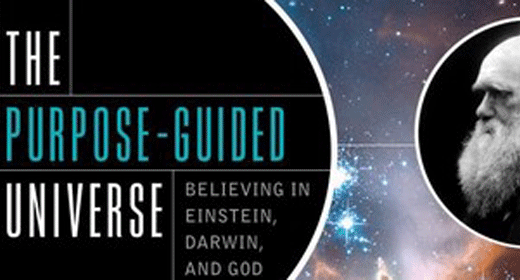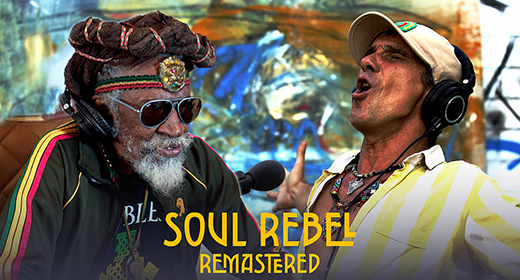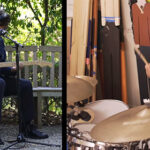Loving-kindness and compassion are the basis for wise, powerful, sometimes gentle, and sometimes fierce actions that can really make a difference — in our own lives and those of others. —Sharon Salzberg
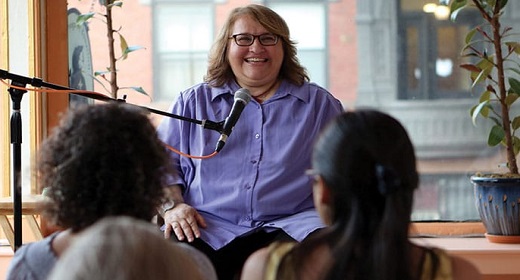
Sharon Salzberg is one of today’s best-known Buddhist teachers. It is her own life’s experience of suffering — and her bravery in sharing stories of her relationship with that suffering — that has inspired so many people around the world, Buddhist practitioners and non-secular meditators alike. Through her unique interpretation of Buddhist teachings and her commitment to sharing what she has learned on the Buddhist path, Salzberg has created an impressive portfolio of teachings, many of which Lion’s Roar and Buddhadharma: The Practitioner’s Quarterly have published. Read below for some of our favorites and to learn more about her life’s journey and work.
![]()
The Life of Sharon Salzberg
EARLY LIFE
Sharon Salzberg experienced suffering early on in her life. She was born to a Jewish family in New York City in 1952, and at the age of just four years old, her parents divorced. Her father, whom she adored, disappeared shortly thereafter. When she was nine, Salzberg’s mother, who was recovering from surgery, began bleeding violently next to her daughter on the couch. This was the last time Salzberg would see her mother, who passed away in hospital two weeks later. Salzberg went to live with her grandparents, and her estranged father returned when she was eleven years old after her grandfather’s death. Shortly after, her father overdosed on sleeping pills. He entered the mental health system and remained there until his death.
In her book Faith, Salzberg writes how it seems she spent most of her childhood “curled up in bed, lost in a separate shadowed existence built of sadness.” She fantasized about having a normal life. “My whole life was an effort to balance on the edge of what felt like an eroding cliff where I was stranded,” she writes. The teachings of Buddhism would eventually turn her life around.
FINDING BUDDHISM
In 1969, Salzberg entered the State University of New York at Buffalo at age 16. She enrolled in a philosophy of Buddhism class in the Asian studies department, and encountered the Buddha’s teachings on suffering in the form of the Four Noble Truths. Salzberg immediately knew them to be true, and learned that meditation was said to liberate us from suffering. “Some inner knowing of what I had been waiting for was stirred,” she writes.
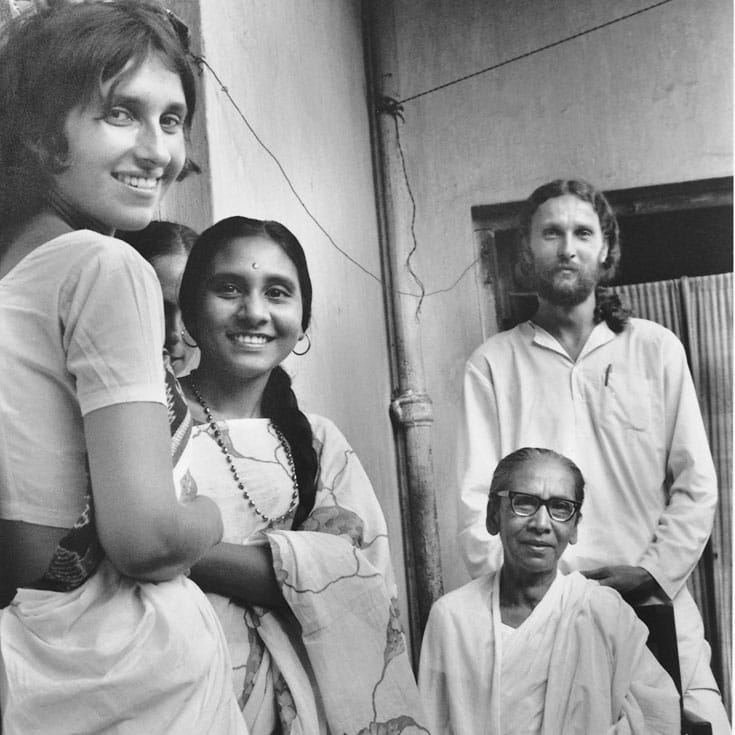
Sharon Salzberg (left) and her teacher Dipa Ma (seated right). Photo courtesy of Insight Meditation Society.
Salzberg took an independent study trip to India the next year, where she faced a series of both challenges and awakenings. In December of 1970, she arrived at Bodh Gaya, the site of the bodhi tree where the Buddha is said to have attained enlightenment. She entered an intensive, ten-day meditation retreat on the outskirts of town led by Vipassana (Insight) meditation teacher S.N. Goenka. Under his direction, Salzberg took refuge in the Buddha, had her first introduction to the practice of meditation, and met a number of people who would become influential Western Buddhist teachers, as well as some of her closest friends—including Ram Dass, Jack Kornfield, and Joseph Goldstein.
Soon after her retreat with Goenka, Salzberg became a student of the “whimsical” Indian teacher Anagarika Munindra, whose simplistic teaching style she deeply admired. She went on to meet a former student of his, meditation teacher Dipa Ma, for whom she felt an instant affection, and became her student.
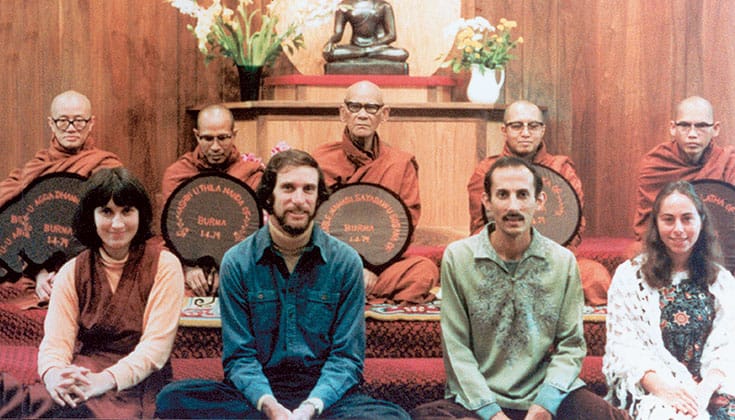
Burmese Vipassana master Mahasi Sayadaw (back row center) conducts a teacher authorization ceremony in 1979 for IMS founding members Sharon Salzberg, Joseph Goldstein, Jack Kornfield, and Jacqueline Mandell-Schwartz. Photo courtesy of Insight Meditation Society.
INSIGHT MEDITATION SOCIETY AND SALZBERG TODAY
In 1974, at the age of 21, Salzberg returned to the U.S., where she took all she had learned during her time in India and began teaching Vipassana (Insight) meditation at the Naropa Institute, along with fellow attendant of her initial Goenka retreat, Joseph Goldstein. She and the friends she had made in India began teaching meditation across the country, and after leading many retreats, Salzberg, Goldstein, Jack Kornfield, and Jacqueline Mandell-Schwartz purchased a former Catholic monastery on eighty acres of land in Barre, Massachusetts, and founded the Insight Meditation Society (IMS) in 1974. IMS would go on to become on of Western Buddhism’s most important institutions.
In 1989, Salzberg and Goldstein co-founded the Barre Center for Buddhist Studies, and nine years later, The Forest Refuge, a long-term meditation retreat center. Salzberg has gone on to lead meditation retreats all over the world, with an emphasis is on Vipassana and Metta (loving-kindness) meditation.
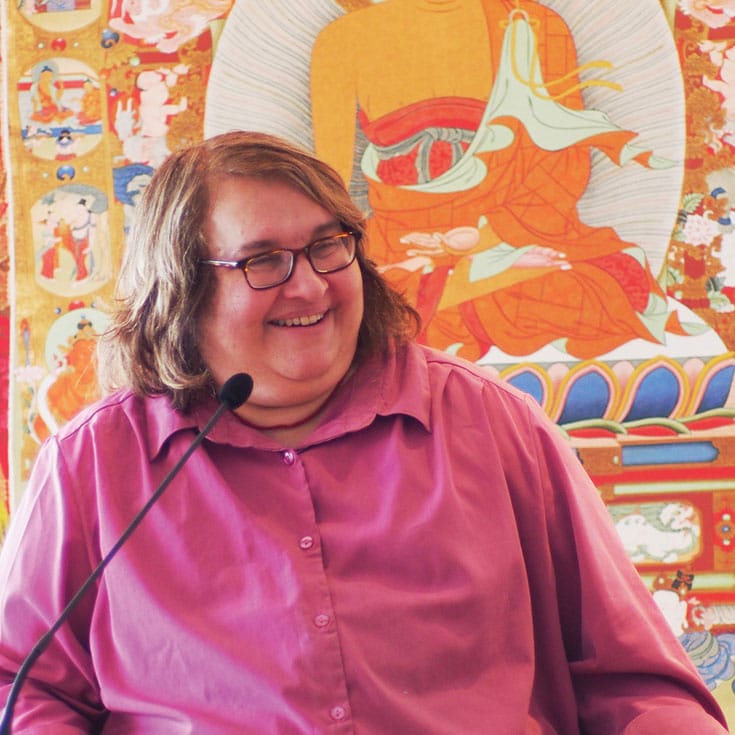
Photo by Olivier Riché.
Today, Salzberg serves a worldwide audience through her teachings, retreats, and writings on the power of meditation. She is the author of nine books, including the bestsellers Faith, Lovingkindness, and Real Happiness. She is a columnist for Krista Tippett’s On Being, and has written for a number of publications, including Buddhadharma: The Practitioner’s Quarterly, Huffington Post, Time Magazine, Yoga Journal, Tricycle, and Real Simple. She has spoken and taught at a variety of events and conferences worldwide. Her voice continues to impact and inspire others, Buddhist and non-Buddhist alike, to cultivate a better life through the practice of meditation.
![]()
Quotes from Sharon Salzberg
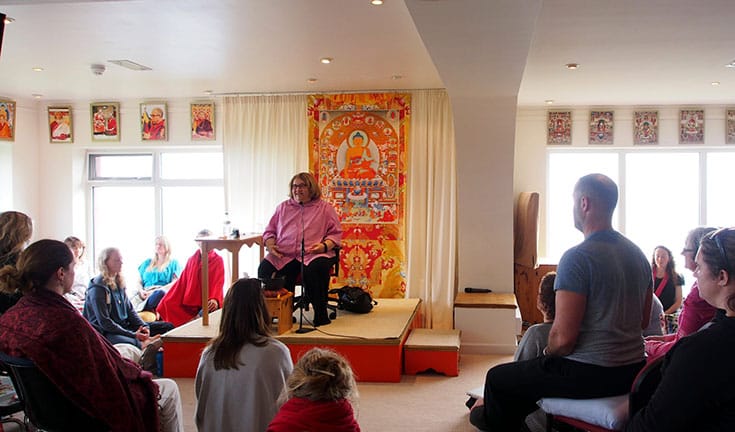
Photo by Photo by Olivier Riché.
There’s no commodity we can take with us. There is only our lives, whether we live them wisely or whether we live them in ignorance. And this is everything.
When you’re wide open, the world is a good place.
If you go deeper and deeper into your own heart, you’ll be living in a world with less fear, isolation, and loneliness.
Faith is not a commodity that you either have or don’t have enough of, or the right kind of. It’s an ongoing process.
Life is like an ever-shifting kaleidoscope; a slight change, and all patterns and configurations alter.
![]()
Sharon Salzberg’s teachings on meditation

In meditation, “rest your attention lightly—as lightly as a butterfly rests on a flower,” says Sharon Salzberg. Photo by Prachanart Viriyaraks.
GETTING STARTED WITH MEDITATION
“If you have to let go of distractions and begin again thousands of times, fine. That’s not a roadblock to the practice—that is the practice. That’s life: starting over, one breath at a time.”
Sharon Salzberg explains the ins and outs of a core technique—meditating on the breath.
SIT LIKE A MOUNTAIN: AN IMAGE OF EQUANIMITY
“Sit like a mountain. Sit with a sense of strength and dignity. Be steadfast, be majestic, be natural and at ease in awareness. No matter how many winds are blowing, no matter how many clouds are swirling, no matter how many lions are prowling, be intimate with everything and sit like a mountain.”
Sharon Salzberg teaches on why equanimity is important, and how to foster it.
WATCH SHARON SALZBERG’S “BUBBLE MEDITATION”
“The Buddha told us to contemplate our conditioned existence in this fleeting world. Like a tiny drop of dew, or a bubble floating in a stream.”
Meditation teacher Sharon Salzberg teaches how to do “bubble meditation.”
WATCH AS SHARON SALZBERG TEACHES “STREET LOVING-KINDNESS”
“May you be safe. May you be happy. May you be healthy. May you be of ease.”
Meditation teacher Sharon Salzberg shows how to bring the mind of metta, or loving-kindness, to the fore by taking the opportunity to offer wishes of goodwill and happiness to all
AWAKENING CONFIDENCE IN OUR CAPACITY FOR LOVING KINDNESS: THE BLESSING OF DIPA MA
“The power of her tremendous motivation could be felt behind her warmth and lovingkindness. It was obvious how meditation practice had given her back her life.”
Sharon Salzberg explores the life and practice of the Buddhist meditation teacher known affectionately as Dipa Ma.
![]()
Sharon Salzberg’s teachings on life, joy, and suffering
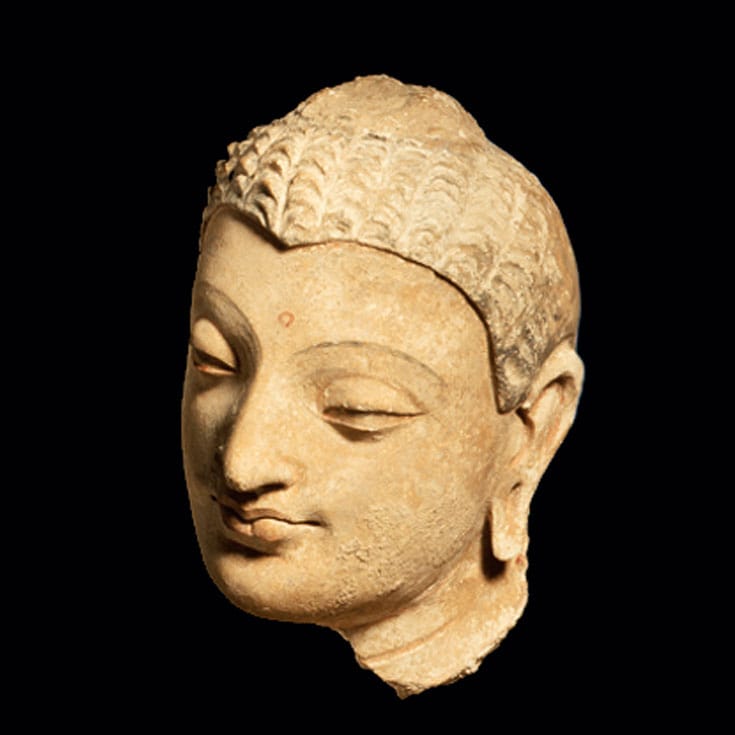
Head of Buddha Shakyamuni. Afghanistan, 4th-5th century. Courtesy of LACMA.
ON SUFFERING AND THE END OF SUFFERING
“In any experience, even a painful one, we can find the end of suffering right in the heart of the moment.”
Sharon Salzberg unpacks the Buddha’s teachings on suffering, and the meaning it’s had in her own life.
SURPRISED BY JOY
“Life can and does turn on a dime. One little rotation of the wheel of fortune, and we’re no longer feeling so on top of life and impervious to change.”
The road to happiness, says Sharon Salzberg, is paved with kindness.
KNOW YOUR ENEMY
“‘Everyone can play’ is now the precept I live by. We may not agree with one another. We may argue. We may compete. But everybody gets to play, no matter what.”
We call people who harm us enemies, but is that who they really are? When we see the person behind the label, say Buddhist teachers Sharon Salzberg and Robert Thurman, everyone benefits.
BECOMING THE ALLY OF ALL BEINGS
“We are all bodhisattvas, not in the sense of being saviors running around taking care of everybody’s problems, but through the truth of interconnectedness. There is no separation. We all belong to each other.”
A teaching by Sharon Salzberg on the interconnectedness of all things.

Photo by Evan Kirby.
GENEROSITY’S PERFECTION
“In the practice of generosity, we learn to see through our attachments.”
Giving up, giving in, just plain giving—Sharon Salzberg says that’s the truly transformative experience. Generosity opens our heart, frees us from attachment and is the basis of all good qualities. It’s the foundation of the Buddhist path.
THE MATURING OF FAITH
“In order to deepen our faith, we have to be able to try things out, to wonder, to doubt. In fact, faith is strengthened by doubt when doubt is a sincere, critical questioning combined with deep trust in our own right and ability to discern the truth.”
![]()
About Sharon Salzberg and Insight Meditation Society
HOW SHARON SALZBERG FOUND REAL HAPPINESS
Facing her suffering head-on has made Sharon Salzberg one of today’s most relatable Buddhist teachers. Lindsay Kyte talks to Salzberg about her difficult life’s journey, establishing loving-kindness as a key practice in American Buddhism, and how we can all find real happiness.
TO LOVE ABUNDANTLY: SHARON SALZBERG’S JOURNEY ON THE PATH
How Sharon Salzberg found loving-kindness in the darkest of times.
THIS FANTASTIC, UNFOLDING EXPERIMENT
Reflecting on the history of the Insight Meditation Society and Spirit Rock Meditation Center, Jack Kornfield describes the challenges and tensions that have accompanied the movement to bring Buddhism to the West and the creative solutions that have emerged to meet them.
INSIGHT MEDITATION AT 25
The idea was almost too ridiculous to contemplate. Three twenty-something meditation teachers, who had spent most of their adult lives wandering around Asia, now stood in front of a 150-room, former Catholic monastery-complete with bowling alley-in the hills of central Massachusetts. They were debating whether to buy it.
![]()
In conversation
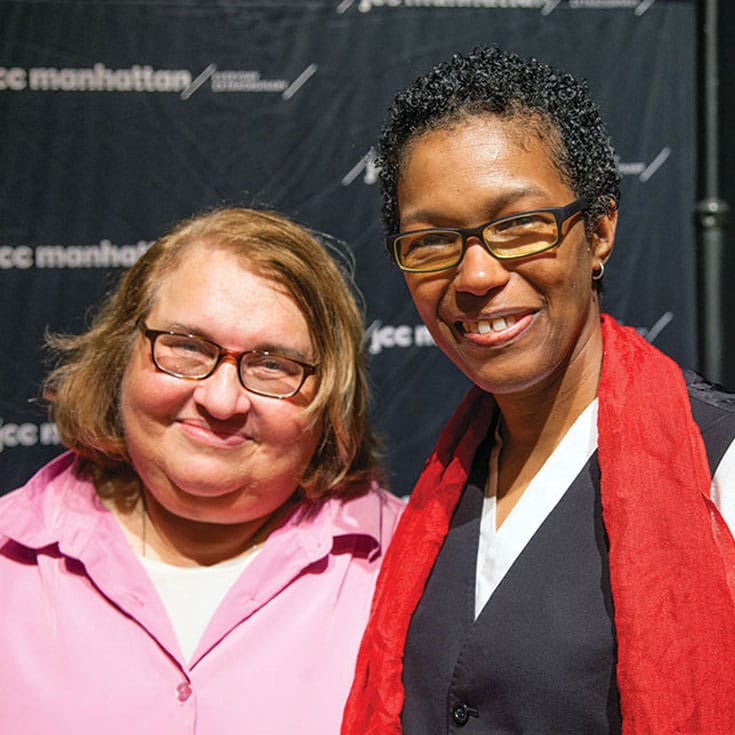
Sharon Salzberg (left) and Rev. angel Kyodo williams (right). Photo by Christine Alicino.
LOVE EVERYONE: A GUIDE FOR SPIRITUAL ACTIVISTS
“The sense of replenishment we get from our own happiness is a gift not only to ourselves but to others.”
Real political change must be spiritual. Real spiritual practice has to be political. Buddhist teachers Sharon Salzberg and Rev. angel Kyodo williams on how we can bring the two worlds together to build a more just and compassionate society.
IS MEDITATION ENOUGH?
“The greatest source of faith or confidence in the path is one’s own experience of the power of one’s own mind or inherent goodness, which meditation can readily provide.”
Sharon Salzberg, Geoffrey Shugen Arnold, and Gaylon Ferguson examine the central role of meditation in Western Buddhism and explore how other practices, such as study and ritual, may or may not be necessary.
TRUE STORIES ABOUT SITTING MEDITATION
“The experience of meditation is one of the most healing things we can do.”billkau
Sharon Salzberg, Charlotte Joko Beck, Joseph Goldstein, and Sylvia Boorstein talk about their own experiences of self-discovery through sitting meditation.
START WITH A FLOWER: ALICE WALKER & SHARON SALZBERG
“It’s so healing to recognize our connection. I’ve received a lot from people who had very little.”
Melvin McLeod sits down with Alice Walker and Sharon Salzberg.
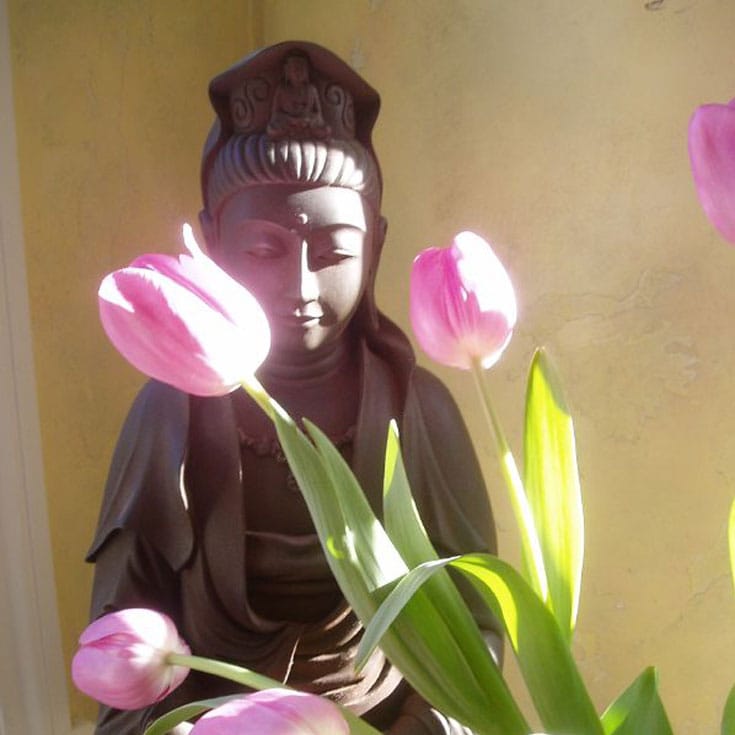
Quan Yin. Robbi Baba.
WOMEN’S LIBERATION
“I teach so much about loving-kindness, and people often say to me that it’s because I’m a woman. I actually like to think not. I like to think it’s more a reflection of something very basic in the teachings of the Buddha.”
Sharon Salzberg, Barbara Rhodes, Judith Simmer-Brown & Pat O’Hara on what it means to be a woman dharma teacher and how they’d like to see Buddhism in America evolve.
FORUM: HOW TO BE A STUDENT
“Overall, faith in the teacher is critical, and the first kind of faith we have is called, in the Theravada tradition, bright faith. You’re sitting alone in a dark, constrained room and the door is closed. Then, something happens. The door swings open and you have a sense of possibility you didn’t have before.”
Sharon Salzberg, Norman Fischer, and Dzogchen Ponlop Rinpoche on how the student-teacher relationship really works.
![]()
Books by Sharon Salzberg
REAL HAPPINESS
Workman Publishing Company
This is an ideal book for anyone interested in beginning a meditation practice. In the opening chapters of Real Happiness, Sharon Salzberg, a founder of the Insight Meditation Society, discusses what meditation is and isn’t, and how it can enrich our lives. Then she dives into the meat of the book—a step-by-step, twenty-eight-day program showing readers how to develop their own practice. Week one focuses on concentration, as well as practicalities such as where and when to meditate. The second week focuses on mindfulness and the body, and includes instructions for walking, body sensation, and drinking tea meditations. Week three concentrates on emotions, particularly difficult ones, and the fourth week explains how to cultivate compassion for ourselves and others. Real Happiness includes a CD with four guided meditations, and features a final chapter on how we can keep our practice going.
FAITH
Riverhead Books
“I want to invite a new use of the word faith, on that is not associated with a dogmatic interpretation or divisiveness,” writes Sharon Salzberg in the introduction of her book Faith: Trusting your own deepest experience. In Faith, Salzberg traces her spiritual quest from childhood to the present, exploring how faith played its part in bringing her out of each trial and tribulation. Intertwined with Buddhist teachings, Salzberg explains how she learned to trust her own truth, and find her authentic self. Faith itself, Salzberg writes, is “the ability to offer our heart to the truth of what is happening, to see our experience as the embodiment of life’s mystery, the present expression of possibility, the conduit connecting us to a bigger reality.”
LOVINGKINDNESS
Shambhala
In Lovingkindness, Sharon Salzberg focuses on the Buddhist practice of metta, or loving-kindness. Salzberg explains how to do loving-kindness meditation, drawing on Buddhist teachings from various traditions and her own personal experience. Lovingkindness offers many guided meditations that the reader can practice to spread metta to themselves, their friends and family, and the world at large. The book itself acts as a teaching on how to cultivate love, compassion, joy, and equanimity in one’s life.
THE KINDNESS HANDBOOK
Sounds True
There’s a warmth to Sharon Salzberg, both in person and in her writing, and it’s this warmth that comes through in The Kindness Handbook. The text is simply written and is straightforward, yet it implies a depth of understanding that belies its surface simplicity. The book is a collection of short essays and anecdotes giving us a foundation and definition for kindness, both for ourselves and others, and then encouragement and guidance on how to take kindness out into the world and into our lives. The book is written in three parts: the first defines kindness for us, the second gives suggestions on how we can be more kind to ourselves, and the third offers ways to manifest that kindness towards others we meet, whether we know them or not, and whether we like them or not. There are essentially two ways to use this book, from chapter to chapter or by opening to any page and using what is on the page as a meditation on what is there, but either way, this is a book to be enjoyed like a good meal or a good cup of coffee: by savoring every bit of it.






